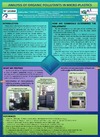Please use this identifier to cite or link to this item:
https://accedacris.ulpgc.es/handle/10553/75119
| DC Field | Value | Language |
|---|---|---|
| dc.contributor.author | Santana Viera, Sergio | en_US |
| dc.contributor.author | Guedes Alonso, Rayco | en_US |
| dc.contributor.author | Afonso Olivares, Cristina | en_US |
| dc.contributor.author | Montesdeoca Esponda, Sarah | en_US |
| dc.contributor.author | Torres Padrón, María Esther | en_US |
| dc.contributor.author | Sosa Ferrera, María Zoraida | en_US |
| dc.contributor.author | Santana Rodríguez, José J. | en_US |
| dc.date.accessioned | 2020-10-29T15:05:27Z | - |
| dc.date.available | 2020-10-29T15:05:27Z | - |
| dc.date.issued | 2016 | en_US |
| dc.identifier.isbn | 9780128122716 | en_US |
| dc.identifier.uri | https://accedacris.ulpgc.es/handle/10553/75119 | - |
| dc.description.abstract | The occurrence of micro-plastics (MPs) in the ocean is an emerging world-wide concern. They present a high sorption capacity for hydrophobic organic chemicals (HOCs) and may play an important role in their transport processes [1]. MPs particles (among which are mostly found polyethylene and polypropylene) are potentially dangerous to marine species due to magnification risk over the food chain [2]. Some authors have detected concentrations of different organic pollutants in MPs, which ranged from 27 to 980 ng/g (Polychlorinated Biphenyls (PCBs)), from 22 to 7100 ng/g (Dichloro-diphenyl-trichloroethanes (DDTs)), from 39 to 1200 ng/g (Polycyclic Aromatic Hydrocarbons (PAHs)) and aliphatic hydrocarbons from 1.1 to 8600 µg/g [3]. In another work the same authors found that over 50% of them contained PCBs, 40% contained pesticides and nearly 80% contained PAHs in concentrations ranged from a few ng/g to thousands of ng/g. In addition, these plastic particles were mostly polyethylene which is resistant to degradation and although functioning similarly to sediments in accumulating pollutants, these had remained on or near the ocean surface [4]. MPs may play also an important role in the fate and transport of pharmaceuticals and personal care products (PPCPs) [5]. Our research group, Environmental Chemical Analysis – Institute of Environmental Studies and Natural Resources, has experience in the determination of trace pollutants in different solid matrices. We want to apply this knowledge to the area of MPs, using techniques like Solid Phase Extraction (SPE) and Microwave Assisted Extraction (MAE) for the extraction and pre-concentration of the pollutants and performing their determination by Liquid Chromatography (LC) coupled to Mass Spectrometry (MS/MS) [6-8]. Using these techniques, we propose the study of different emerging contaminants absorbed onto MPs. | en_US |
| dc.language | eng | en_US |
| dc.publisher | Elsevier | en_US |
| dc.source | MICRO 2016: Fate and Impact of Microplastics in Marine Ecosystems / Juan Baztan; Bethany Jorgensen; Sabine Pahl; Richard Thompson; Jean-Paul Vanderlinden | en_US |
| dc.subject | 2301 química analítica | en_US |
| dc.title | Analysis of organic pollutants in micro-plastics | en_US |
| dc.type | info:eu-repo/semantics/conferenceObject | en_US |
| dc.type | Conference Poster | en_US |
| dc.relation.conference | MICRO 2016 Fate and Impact of Microplastics in Marine Ecosystems: From the Coastline to the Open Sea, 25-27th may 2016, Arrecife (Lanzarote) | en_US |
| dc.investigacion | Ciencias | en_US |
| dc.type2 | Póster de congresos | en_US |
| dc.utils.revision | Sí | en_US |
| dc.identifier.ulpgc | Sí | en_US |
| item.grantfulltext | open | - |
| item.fulltext | Con texto completo | - |
| crisitem.author.dept | GIR IUNAT: Análisis Químico Medioambiental | - |
| crisitem.author.dept | IU de Estudios Ambientales y Recursos Naturales | - |
| crisitem.author.dept | GIR IUNAT: Análisis Químico Medioambiental | - |
| crisitem.author.dept | IU de Estudios Ambientales y Recursos Naturales | - |
| crisitem.author.dept | Departamento de Química | - |
| crisitem.author.dept | GIR IUNAT: Análisis Químico Medioambiental | - |
| crisitem.author.dept | IU de Estudios Ambientales y Recursos Naturales | - |
| crisitem.author.dept | Departamento de Química | - |
| crisitem.author.dept | GIR IUNAT: Análisis Químico Medioambiental | - |
| crisitem.author.dept | IU de Estudios Ambientales y Recursos Naturales | - |
| crisitem.author.dept | Departamento de Química | - |
| crisitem.author.dept | GIR IUNAT: Análisis Químico Medioambiental | - |
| crisitem.author.dept | IU de Estudios Ambientales y Recursos Naturales | - |
| crisitem.author.dept | Departamento de Química | - |
| crisitem.author.dept | GIR IUNAT: Análisis Químico Medioambiental | - |
| crisitem.author.dept | IU de Estudios Ambientales y Recursos Naturales | - |
| crisitem.author.dept | Departamento de Química | - |
| crisitem.author.orcid | 0000-0002-2412-0037 | - |
| crisitem.author.orcid | 0000-0002-9189-9589 | - |
| crisitem.author.orcid | 0000-0002-3089-4549 | - |
| crisitem.author.orcid | 0000-0001-9872-5293 | - |
| crisitem.author.orcid | 0000-0001-7000-4419 | - |
| crisitem.author.orcid | 0000-0003-3003-3607 | - |
| crisitem.author.orcid | 0000-0002-5635-7215 | - |
| crisitem.author.parentorg | IU de Estudios Ambientales y Recursos Naturales | - |
| crisitem.author.parentorg | IU de Estudios Ambientales y Recursos Naturales | - |
| crisitem.author.parentorg | IU de Estudios Ambientales y Recursos Naturales | - |
| crisitem.author.parentorg | IU de Estudios Ambientales y Recursos Naturales | - |
| crisitem.author.parentorg | IU de Estudios Ambientales y Recursos Naturales | - |
| crisitem.author.parentorg | IU de Estudios Ambientales y Recursos Naturales | - |
| crisitem.author.fullName | Santana Viera, Sergio | - |
| crisitem.author.fullName | Guedes Alonso, Raico Iván | - |
| crisitem.author.fullName | Afonso Olivares, Cristina | - |
| crisitem.author.fullName | Montesdeoca Esponda, Sarah | - |
| crisitem.author.fullName | Torres Padrón, María Esther | - |
| crisitem.author.fullName | Sosa Ferrera, María Zoraida | - |
| crisitem.author.fullName | Santana Rodríguez, José Juan | - |
| Appears in Collections: | Póster de congreso | |
Page view(s)
70
checked on Dec 2, 2023
Download(s)
99
checked on Dec 2, 2023
Google ScholarTM
Check
Altmetric
Share
Export metadata
Items in accedaCRIS are protected by copyright, with all rights reserved, unless otherwise indicated.
